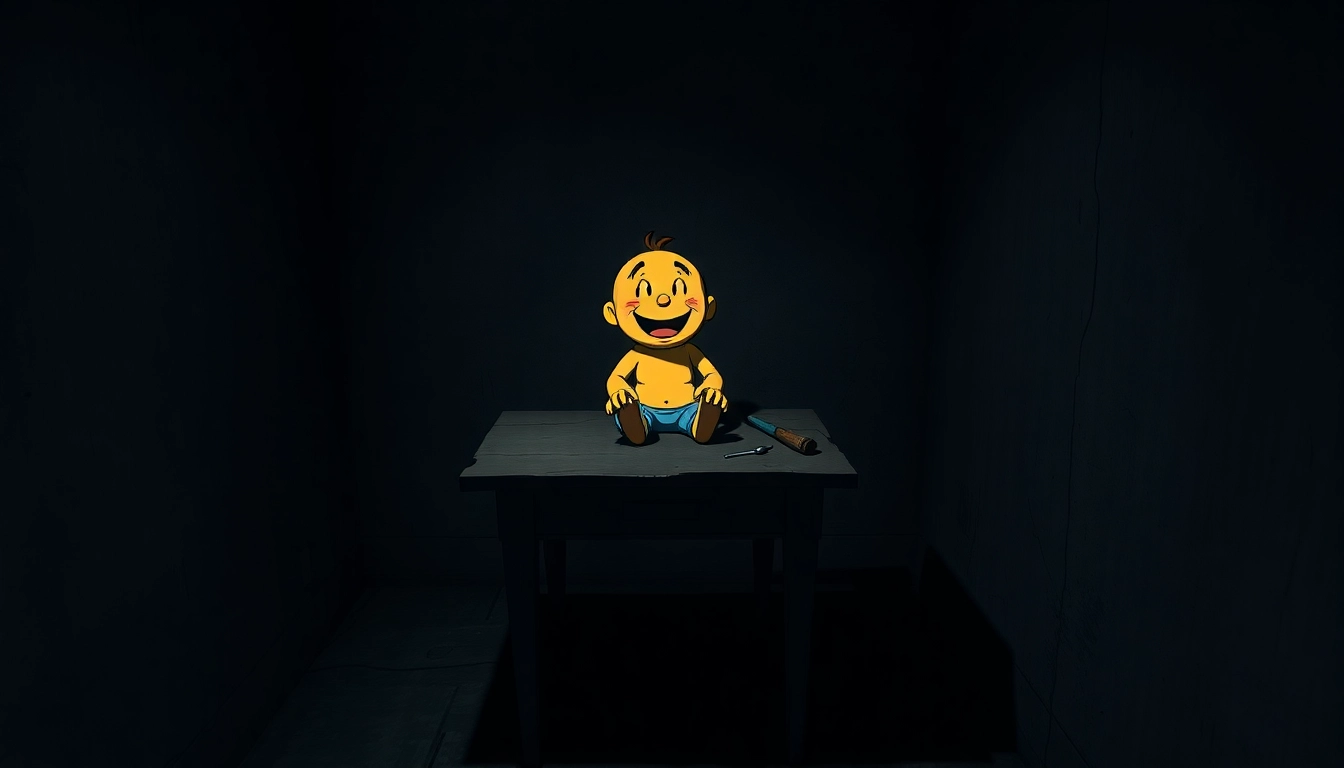Overview and Context: The Disturbing Dark Clicker Experience of BLOODMONEY
In the realm of psychological horror and morally challenging gaming experiences, blood money stands out as a uniquely unsettling title. This dark clicker game immerses players in a harrowing journey where each interaction not only yields monetary gain but also erodes moral boundaries and tests the limits of human conscience. Designed by SHROOMYCHRIST, BLOODMONEY combines minimalistic yet disturbing visuals, a gripping narrative, and intense gameplay mechanics to provoke deep reflection on the nature of morality, desperation, and survival.
Game Mechanics and Core Gameplay
Clicking Mechanics and Profit Generation
At its core, BLOODMONEY employs a straightforward yet profoundly impactful clicking mechanic. Players are tasked with clicking on a cheerful character named Harvey, whose innocent appearance belies the dark consequences of each interaction. Every click on Harvey generates a set amount of money—initially a modest sum—needed desperately to cover a life-threatening medical expense. For many players, this mechanic echoes classic idle and clicker games, but with a sinister twist. As you click, Harvey’s visual reactions subtly change, becoming increasingly distressed or pained, hinting at the moral cost of your actions.
Upgrade System and Progressive Tools
To accelerate earnings, players can purchase upgrades from the in-game shop. These upgrades start innocuously—perhaps pillows or harmless objects—but rapidly escalate to more violent and disturbing tools such as scissors, needles, and hammers. Each upgrade not only boosts profit but also amplifies Harvey’s suffering, with visual cues and dialogue reflecting his deteriorating state. The game’s upgrade system creates a risk-reward dynamic: the more violent and efficient your tools, the faster you reach your financial goal, but at what moral cost? The choices made here shape the emotional and visual tone of the game.
The Dark Narrative of BloodMoney: Exploring the Moral Dilemma
The Background: A Fight Against Time and Morality
You are diagnosed with a severe health condition, and your medical bills amount to an overwhelming $25,000. Time is critically limited; every second counts as you seek an escape from financial despair. A strange, unsettling opportunity arises in Harvey—a cheerful, seemingly innocent character—who offers you a bizarre proposition: click on him to generate money. The premise is simple but profoundly disturbing: each click benefits you financially at Harvey’s expense. As the game unfolds, the narrative pushes players to confront uncomfortable questions about the limits of morality in desperate circumstances.
The Desperate Situation and Harvey’s Proposition
Harvey’s cheerful demeanor initially evokes empathy, but as you continue clicking, the tone darkens. Harvey begins to show signs of pain, and the visuals become more disturbing with each click—blood, tears, and expressions of suffering. The game intentionally blurs the line between innocence and horror, forcing players to grapple with their own moral boundaries. Harvey’s offer becomes increasingly sinister as the shop introduces tools that result in more violent and traumatic outcomes. The question looms: how much are you willing to sacrifice to survive?
Featured Gameplay Videos and Player Engagement
The game’s disturbing premise has garnered significant attention across gaming communities and video platforms. Featured gameplay videos showcase the evolution of Harvey’s reactions, the strategic choices players make, and the emotional toll of their decisions. These videos often highlight the stark contrast between the cheerful initial interactions and the gruesome outcomes of violent upgrades. Community reactions range from shock and guilt to fascination with the game’s raw psychological impact. Such videos serve as both entertainment and a reflection of the moral dilemmas embedded within BLOODMONEY.
Clicking Mechanics and Visual Cues
Progressive Visual Deterioration and Emotional Impact
One of the most compelling aspects of BLOODMONEY is how it utilizes visual cues to deepen the emotional resonance. Harvey’s appearance changes subtly with each click—his smile fades, eyes well up with tears, and his body language shifts from cheerful to fearful. These cues serve as a visual diary of moral decay, making players acutely aware of the human suffering behind their actions. The game’s art style, minimalist yet visceral, amplifies the unsettling atmosphere and reinforces the psychological horror.
Dialogue and Subtle Clues
Dialogue within the game further enriches this experience. Harvey’s lines shift from innocent humor to expressions of fear and confusion. Notably, players have observed that Harvey sometimes appears surprised or confused by the violent tools bought from the shop—implying he might not fully understand what is being done to him. This subtle detail adds a layer of moral ambiguity, suggesting Harvey may be unaware of the true nature of the upgrades, which intensifies the game’s exploration of innocence and complicity.
Upgrade System and Its Psychological Consequences
Tools That Maximize Profit and Suffer
The upgrade system is central to the moral complexity of BLOODMONEY. Starting with innocuous objects like pillows, the shop quickly introduces more violent tools such as scissors, knives, and hammers. Each upgrade increases the amount of money earned per click but also significantly amplifies Harvey’s pain and suffering. The visual and auditory cues—cries, blood, trembling—are designed to evoke empathy and discomfort simultaneously. This duality challenges players to consider whether increasing profit is worth the escalating human cost.
Visual and Psychological Consequences
As Harvey endures more violent upgrades, his visuals reflect the toll—his face becomes bloodied, his eyes shut in pain, and his body language screams distress. The game doesn’t shy away from showing these disturbing images, pushing players to confront their own potential for moral compromise. The psychological impact is heightened by the game’s ambient sound design and dialogue, which become more frantic and despairing as Harvey’s suffering intensifies.
Multiple Pathways and Endings: The Moral Outcomes
The Three Endings: Good, Normal, and Bad
BLOODMONEY culminates in three distinct endings, each determined by the player’s choices and upgrade paths:
- The Good Ending: Minimal harm. You purchase only non-violent upgrades, causing Harvey the least suffering. You reach your financial goal but at a moral cost—preserving some semblance of innocence.
- The Normal Ending: Moderate violence. You opt for tools like scissors, which cause more pain but expedite reaching your goal. Harvey’s suffering is evident, but you manage to survive.
- The Bad Ending: Maximum violence and efficiency. You buy the most brutal tools, like hammers, causing Harvey extreme pain. This path results in the most disturbing visuals and a morally compromised ending, often marked by Harvey’s complete breakdown or demise.
How Choices Shape the Narrative
The game tracks subtle player behaviors—such as the types of upgrades purchased, clicking frequency, and reactions to Harvey’s pain—to determine the ending. Interestingly, players have discovered that even using violent tools like hammers can sometimes still lead to the Good Ending if certain conditions are met. This nuance underscores the game’s intricate design, emphasizing that moral choices are complex and multifaceted.
Community Insights and Player Reactions
Player Discussions and Theories
The BLOODMONEY community is vibrant and deeply engaged. Players share insights about the game’s hidden mechanics, moral implications, and their emotional responses. Many express feelings of guilt, empathy, or discomfort, highlighting the game’s powerful psychological impact. Discussions often revolve around Harvey’s reactions, the symbolism of the tools, and the possibility of achieving different endings through nuanced gameplay strategies.
Notable Observations and Hidden Details
Players have pointed out subtle clues that deepen the moral ambiguity—such as Harvey’s surprise at violent tools, implying he might not understand the full scope of what’s happening. Others note the gradual change in Harvey’s visual state as a mirror of their own moral journey, making each playthrough a deeply personal experience. These observations enrich the game’s replayability and philosophical depth.
The Psychological Horror Experience: Why BLOODMONEY Is Unique
Emotional Impact and Visual Design
BLOODMONEY’s strength lies in its ability to evoke genuine emotional responses. The minimalist art style, combined with visceral visuals and sound design, creates an atmosphere of escalating dread. The visual cues—Harvey’s changing expressions, blood, tears—serve as constant reminders of the moral sacrifices made with each click. The game’s pacing, which gradually intensifies, keeps players immersed and emotionally engaged.
Testing Human Morality
More than just a game, BLOODMONEY functions as a psychological experiment. It prompts players to question their own morality and the extent to which desperation influences ethical boundaries. The game’s design forces a confrontation with uncomfortable truths about human nature: Are we inherently good or evil when pushed to our limits? The moral choices are never black-and-white, which makes the experience profoundly thought-provoking.
Comparing BLOODMONEY to Other Dark Clicker Games
While the clicker genre has seen various titles emphasizing profit and progression, BLOODMONEY distinguishes itself through its intense moral narrative and psychological depth. Unlike many idle games that focus purely on efficiency and reward, BLOODMONEY challenges players with ethical dilemmas and visceral visuals. It shares similarities with other dark-themed titles but elevates the genre by integrating storytelling, emotional design, and moral complexity.
Ethical Questions and Real-World Parallels
The game’s premise mirrors real-world dilemmas surrounding survival, sacrifice, and morality. It invites reflection on whether actions that are morally questionable can be justified when life hangs in the balance. BLOODMONEY’s disturbing premise forces players to consider questions like: How far would you go for your health? Does the end justify the means? The game acts as a mirror to society, prompting discussions about the ethics of desperation and the human capacity for moral compromise.
Final Thoughts: Morality, Desperation, and the Unmasking of Humanity
BLOODMONEY masterfully combines psychological horror, moral complexity, and engaging gameplay to create a deeply unsettling experience. Its innovative use of visual storytelling, subtle cues, and branching endings makes it more than just a clicker game—it’s a reflection on human nature and the choices we make under pressure. Whether you aim for the least harm or maximize efficiency regardless of human suffering, each path offers a different perspective on morality and survival. The game leaves players pondering: how far are you willing to go when your life depends on it?
In the end, BLOODMONEY challenges us to confront our own moral boundaries and consider what truly defines us in moments of desperation. As you navigate this dark journey, remember that every click echoes a moral decision—one that may reveal the darker depths of your own humanity. For those intrigued by this unsettling exploration, dive into the game and explore the profound questions it raises about morality, suffering, and survival. Discover more about this haunting experience and connect with the community through blood money.

